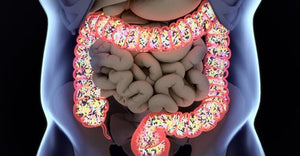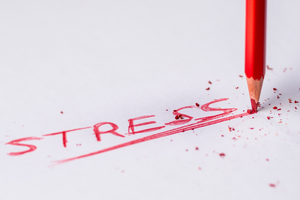Better Sleep for Those with Fibromyalgia

By Dr. David M. Brady and Danielle Moyer
What would be the perfect storm for disrupted sleep? Probably some combination of widespread pain, abnormal pain perception, and heightened awareness and sensitivity to stimuli (touch, light, and sound), and anxiety [1]. Unfortunately, these are the exact symptoms of fibromyalgia, a syndrome that impacts over 4 million US adults every day - about 2% of the population [2]. Sleep disturbances affect 90% of fibromyalgia patients, whose complaints include, “nocturnal restlessness, involuntary leg movements, frequent awakenings and a perception that sleep is light and non-refreshing, with fatigue and stiffness upon waking”[3].
To understand this more, sleep can be broken down into different stages. Approximately 5% consists of wakefulness, 25% is spent in the REM cycle, 50% in the “light” and “intermediate” sleep stage, and 20% in the short-wave sleep. Short-wave sleep is believed to be crucial for restoration, as that is where heart rate, blood pressure, energy use, and stress hormones are decreased, while growth hormone is released. Patients with fibromyalgia, as compared to healthy individuals, have been shown to have reduced short-wave sleep, impacting their quality of sleep. Additionally, during the non-REM portion of sleep, the abnormal pain processing of fibromyalgia triggers something called “alpha-wave intrusion” sleep patterns. Alpha-wave intrusions are associated with wakefulness during deep delta-wave sleep, reinforcing the “nonrestorative” sleep pattern and daytime fatigue in fibromyalgia patients [3].
Looking more closely at the relationship of fibromyalgia and sleep, researchers have found that sleep and pain have a bidirectional role in their progression. On one hand, poor sleep quality can worsen or even initiate symptoms of fibromyalgia, resulting in increased pain, altered pain processing, worsened physical functioning, and altered mood [4]. On the other hand, the abnormal pain processing of fibromyalgia correlates to the reduced deep short-wave sleep and triggered alpha-wave intrusion frequencies explained above. Studies have shown that the interaction of pain and sleep disturbances are associated with the prevalence of depression, anxiety, and stress in patients with fibromyalgia as well [4].
Essentially, studies show that fibromyalgia patients who experience intense pain also tend to experience poor sleep, and vice versa. As a result, therapeutic approaches capable of reducing or eliminating sleep disruptions should have a similar effect on the pain and fatigue symptoms in patients with fibromyalgia [5].
So, how does one break this vicious cycle?
Approaches to improving sleep begin with education around sleep hygiene and management [5]. Here are some tips that would help anyone, including patients with fibromyalgia, improve their sleep through time:
- Set a regular sleep pattern where you go to bed and wake up at the same time every day (including weekends) [6]. One should allow their body 7-8 hours of sleep to repair itself, physically and mentally. This includes considerations of “sleep opportunity” and sleep itself. For example, someone’s sleep opportunity may be the 8 hours they lay in bed, despite actually sleeping for only 6 hours.
- Make your bedroom a relaxing environment. Keep the room dark, quiet, and cool (65 degrees Fahrenheit) [7]. Invest in a comfortable mattress and bedding. Use your bed for sleep – avoid doing work, watching TV, reading, or checking your phone once you’re in bed. Avoid having pets in bed with you that may disturb your sleep.
- Make time to relax every day. Relax with deep-breathing exercises, meditation, listening to soft music, taking a warm bath, and getting out into nature. This can reduce stress and improve sleep quality.
- Exercise frequently, but not within 3 hours of bedtime. With fibromyalgia, exercising can be difficult at first due to the pain. However, studies show that regular exercise and movement can often reduce pain symptoms and fatigue in fibromyalgia. Even walking around one’s neighborhood or home can help to relieve symptoms. Start low and slowly increase the activity through time. Working with a physical therapist, chiropractic physician, trainer, or other knowledgeable health professional can be beneficial. Additionally, exercise is best done earlier in the day to not interfere with sleep [6].
- Avoid drinking caffeine or alcohol, using nicotine, or eating large meals before bedtime [8]. Avoiding any large amount of liquids before bed can lower the chances of having to go to the bathroom in the middle of the night. Caffeine can be snuck into desserts (chocolate), medications, and tea. Alcohol contributes to frequent waking and increased trips to the bathroom during the night. Nicotine in cigarettes acts as a stimulant, which can further disrupt sleep problems [6].
- Lower exposure to stimulating activities right before bed. No scary or intense movies, books, or projects that might make it difficult to fall asleep. The more you can avoid electronic screen exposure within 2-hours of bedtime the better.
- Consider Cognitive Behavioral Therapy (CBT). This encourages patients to change their thought patterns for the better, letting go of negative thoughts that might be inhibiting their ability to sleep [9].
- Research whether your medications may be affecting your sleep as a side effect. Some medications worsen sleep, whereas others improve sleep. Knowing which one you have is important.
There are also other agents, such as supplements, that have been shown to improve sleep overall for people and patients with fibromyalgia. Before taking any supplements, please talk with your doctor, nutritionist, or other healthcare practitioner to see if they are right for you.
- Vitamin D. Vitamin D can reduce pain in patients with conditions such as fibromyalgia, and it has also been shown to improve sleep hygiene in patients with fibromyalgia [10]. It is recommended to get your vitamin D levels checked at your doctors, as it can depend on your geographic location, exposure to sun, and time of the year.
- Melatonin. Melatonin is a natural hormone that the body produces to regulate sleep cycles, but the production of it declines as we age. As a result, taking it in supplemental form can benefit people with fibromyalgia by improving sleep quality and reducing fatigue, as well as reducing pain [11-12].
- 5-HTP (5-Hydroxytryptophan). 5-HTP is converted to the hormone serotonin in the body, which helps us fall asleep. Clinical evidence has shown that taking 100 mg of 5-HTP orally three times a day for 30 to 90 days can improve pain, tenderness, sleep, anxiety, fatigue, and morning stiffness in people with primary fibromyalgia syndrome [13-14].
- Botanical Herbs. Herbs have been used as remedies to improve sleep for decades, and some of the most researched and well tolerated are below [15]. One can find them individually packaged in supplements, or often in combination supplements.
- Valerian (Valeriana officinalis)
- Passionflower (Passiflora incarnata)
- Chamomile (Matricaria chamomilla)
- Lavender (Lavandula angustifolia)
- Lemon Balm (Melissa officinalis)
- L-theanine. L-theanine is a compound found in tea leaves and has been shown to promote relaxation, decrease stress, and relax the mind to promote better sleep, without causing drowsiness or acting as a sedative [16].
When working with a healthcare provider to improve sleep with fibromyalgia, the first step to any therapeutic approach would be to get the patient’s sleep history. This includes factors about their sleep hygiene: Activities done before bed (physical exercise), attitude towards sleep (anxiety present), daytime activities that can impact sleep, dietary and lifestyle factors (caffeine, alcohol, and nicotine use), medications that affect sleep, and any other sleep-disrupting disorders [5].
Improving a person’s sleep is important for anyone, but especially for those with fibromyalgia. Look at the recommendations above and identify one or two that you can start right away. Not only will you feel more rested, but your pain may be lowered as well. Win, win.
References:
- Schneider MJ, Brady DM, Perle SM. Commentary: differential diagnosis of fibromyalgia syndrome: proposal of a model and algorithm for patients presenting with the primary symptom of chronic widespread pain. J Manipulative Physiol Ther. 2006;29(6):493-501. doi:10.1016/j.jmpt.2006.06.010
- Fibromyalgia. Centers for Disease Control and Prevention website. https://www.cdc.gov/arthritis/basics/fibromyalgia.htm. Reviewed January 6th, 2020. Accessed February 23, 2021.
- Choy EHS. The role of sleep in pain and fibromyalgia. Nature Reviews Rheumatology. 2015;11(9):513-520. doi:10.1038/nrrheum.2015.56
- Keskindag B, Karaaziz M. The association between pain and sleep in fibromyalgia. Saudi Med J. 2017;38(5):465-475. doi:10.15537/smj.2017.5.17864
- Spaeth M, Rizzi M, Sarzi-Puttini P. Fibromyalgia and Sleep. Best Practice & Research Clinical Rheumatology. 2011;25(2):227-239. doi:10.1016/j.berh.2011.03.004
- Amigues I. Fibromyalgia. American College of Rheumatology website. https://www.rheumatology.org/I-Am-A/Patient-Caregiver/Diseases-Conditions/Fibromyalgia. Reviewed March 2019. Accessed February 23, 2021.
- Pacheco D. The Best Temperature for Sleep. Sleep Foundation website. https://www.sleepfoundation.org/bedroom-environment/best-temperature-for-sleep. Reviewed October 29, 2020. Accessed February 23, 2021.
- Clauw D. Fibromyalgia. Office of Women’s Health website. https://www.womenshealth.gov/a-z-topics/fibromyalgia. Reviewed April 1, 2019. Accessed February 23, 2021.
- Bennett R, Nelson D. Cognitive behavioral therapy for fibromyalgia. Nat Clin Pract Rheumatol. 2006;2(8):416-424. doi:10.1038/ncprheum0245
- Oliveira DL de, Hirotsu C, Tufik S, Andersen ML. The interfaces between vitamin D, sleep and pain. Journal of Endocrinology. 2017;234(1):R23-R36. doi:10.1530/JOE-16-0514
- Hussain SA-R, Al-Khalifa II, Jasim NA, Gorial FI. Adjuvant use of melatonin for treatment of fibromyalgia. J Pineal Res. 2011;50(3):267-271. doi:10.1111/j.1600-079X.2010.00836.x
- Citera G, Arias MA, Maldonado-Cocco JA, et al. The effect of melatonin in patients with fibromyalgia: a pilot study. Clin Rheumatol. 2000;19(1):9-13. doi:10.1007/s100670050003
- Caruso I, Sarzi Puttini P, Cazzola M, Azzolini V. Double-blind study of 5-hydroxytryptophan versus placebo in the treatment of primary fibromyalgia syndrome. J Int Med Res. 1990;18(3):201-209. doi:10.1177/030006059001800304
- Sarzi Puttini P, Caruso I. Primary fibromyalgia syndrome and 5-hydroxy-L-tryptophan: a 90-day open study. J Int Med Res. 1992;20(2):182-189. doi:10.1177/030006059202000210
- Guadagna S, Barattini DF, Rosu S, Ferini-Strambi L. Plant Extracts for Sleep Disturbances: A Systematic Review. Evid Based Complement Alternat Med. 2020;2020. doi:10.1155/2020/3792390
- Dr. Brady







Comments 0